Yep, it’s that time again – another RIA Premiere Auction is coming up on the weekend of December 6th-8th. As usual, there are thousands of firearms up for sale, including a whole bunch of 1911s, Lugers, P38s, and other classic arms. As is also usual, I’m more interested in the unusual and, dare I say, forgotten weapons that are up for grabs. So, let’s take a look at some of the highlights (which, by the way, it was tough to cull down to just these few)…
Pistols
Let’s dive right into the cool with a 1939 prototype Gustloff .32ACP semiauto pistol (Lot 1392). This was a design intended to compete with the Walther PP/PPK, being made at the Buchenwald concentration camp to reduce costs. The Walther pistol was well liked, though, and with all the other wartime priorities this Gustloff design was never put into production. Mechanically, it is a simple blowback design, with a shrouded hammer. Anticipated price point: used car.
Next up, an older prototype: a Krnka 1895 (Lot 3384). The Czech designer Karel Krnka was the brain behind several innovative early repeating and self-loading pistols (we will be covering his work in more detail in the future). This particular 1895 experimental model of pistol was the grandfather of the Roth-Steyr 1907 (which Krnka designed, Roth financed, and Steyr produced). This pistol uses a locked breech (recoil-operated rotating bolt system), and has a fixed internal magazine fed by stripper clips (one of which is included in the auction). A very early gun from an underappreciated engineer! Anticipated price point: small new car.
Prototypes are great and all, I can hear you saying, but how about something a bit more recognizable, but with a unique twist? Well, how about a 1915 DWM Luger that took a piece of shrapnel for its owner (Lot 1450)? This is certainly not something to appeal to everyone – and may be a bit macabre – but it is certainly a one-of-a-kind artifact. The outside face of its holster shows a large entry hole and the shell fragment making it proceeded to slam into the backstrap of the Luger, twisting and destroying the frame. It broke into smaller pieces as a result of the impact, which left a handful of exit holes on the inside of the holster. Whether this saved the owners life or killed him, there is no way to know… Anticipated price point: One ounce of gold.
Rifles
This is not as rare an item as the pistols above, but the Japanese Type 2 Paratrooper variant of the Arisaka is a very neat rifle – and there are two available in this auction (Lot 608 and Lot 1458). In order to make the weapon more convenient for use jumping out of an aircraft, the Japanese devised a system wherein the barrel and forestock of the rifle can be detached from the receiver by simply unscrewing a captive locking wedge. The system is durable, simple, safe, and quick to use. It also retains the solid stock and full-length barrel to improve practical accuracy, which many countries sacrificed for portability on paratrooper rifles. Anticipated price point: twenty-five typical Turkish Mausers.
Not rare enough for you? Well, how about a Type 1 Paratrooper (Lot 616), an experimental predecessor to the Type 2? Before they got the idea for the detachable barrel, the Japanese toyed with the idea of using a short barrel and a folding stock for a handy rifle. How do you make an easy folding stock carbine? Take a Type 38 Arisaka, saw the stock off at the wrist, and put a big ol’ hinge on it! Yes, this did result in a lot of wobbly and cracked stocks, and I’m sure the Imperial paratroopers were much happier with the Type 2. Still, this Type 1 is in outstanding condition for what it is, and an exceedingly rare find. Anticipated price point: registered MAC-10 (this seems low to me).
For something more high-tech, how about a pair of Remington Etronx bolt action rifles (Lot 905)? These are model 700 rifles using an electronic firing mechanism which allows very light trigger pulls and effectively zero lock time (the time from when you pull the trigger to when the primer detonates). They were a commercial failure for Remington, because they use a battery and require special non-standard primers (although normal brass works fine). Those requirements made the target market skittish, along with the price. Still, the rifle is an interesting innovation, and as far as I can tell they work just great. This lot has one in .22-250 and one in .220 Swift, along with about 1100 rounds of loaded ammo and 7000 more of the electronic primers. Anticipated price point: half the price of a single new Etronx.
M1 Garands
There are no fewer than 16 M1 Garand rifles in this upcoming auction, but two of them in particular jumped out at me. The first is a very early (serial number 20816) example of the gas trap system (Lot 1535). The Garand initially used a system where the muzzle blast was captured and redirected to push the operating piston (similar to the German G41(M) and G41(W)). This was quickly found to be unreliable, though, and the rifles were retrofitted with a gas port in the barrel bleeding gas directly to the oprod – a much better system. Very few of the early M1s escaped this overhaul, and so original gas trap examples are pretty rare today. This particular one was carried by a member of the Alaska National Guard, and also has the even more rare blast deflector used by a few units in the arctic. Sweet! Anticipated price point: small foreclosed house.
The other M1 that made me drool on my catalog was one of 5 selected for use in the 1949 rifle trials where the US and UK tried to come to an agreement on a new NATO rifle cartridge (Lot 3570). Five Garands were converted by the British to .280 in an attempt to convince US Ordnance officers that the .280 round would be effective in the US standard arms (M1, BAR, M1919A4). The attempt failed because US Ordnance (in typical fashion) was unwilling to use a cartridge less powerful than the .30-06. We’re only now coming back around to the practicality of an intermediate cartridge like the .280, and I think an M1 in this caliber would be an absolutely outstanding shooter. Conveniently for a potential purchased who would be willing to fire this rifle, the 1949 version of the .280 uses the same case head and rim dimensions as the .30-06, so making brass ought to be fairly simple. Anticipated price point: 55 pounds of pre-1965 quarters.
Cool Widget
As cool as those M1s are, the prices do put them solidly out of my reach. So here’s something else very neat that we can close on with a price that makes it available to a lot more of us: a Japanese aerial training gun camera (Lot 618). Like the Hythe camera I wrote about a while back, this camera is styled loosely after the Lewis gun (which the Japanese used in aircraft for a long time). Unlike the Hythe, this one is a movie camera. The trainee winds up a drum of film, and holding down the “trigger” causes it to record footage until the trainee releases the trigger. This allows instructors to assess whether the trainee is using proper lead and burst durations. A very cool piece of equipment, this one comes cased with a bunch of accessories including brackets for both wing mounting and flexible ring mounting. Anticipated price point: professional modern handheld video camera.
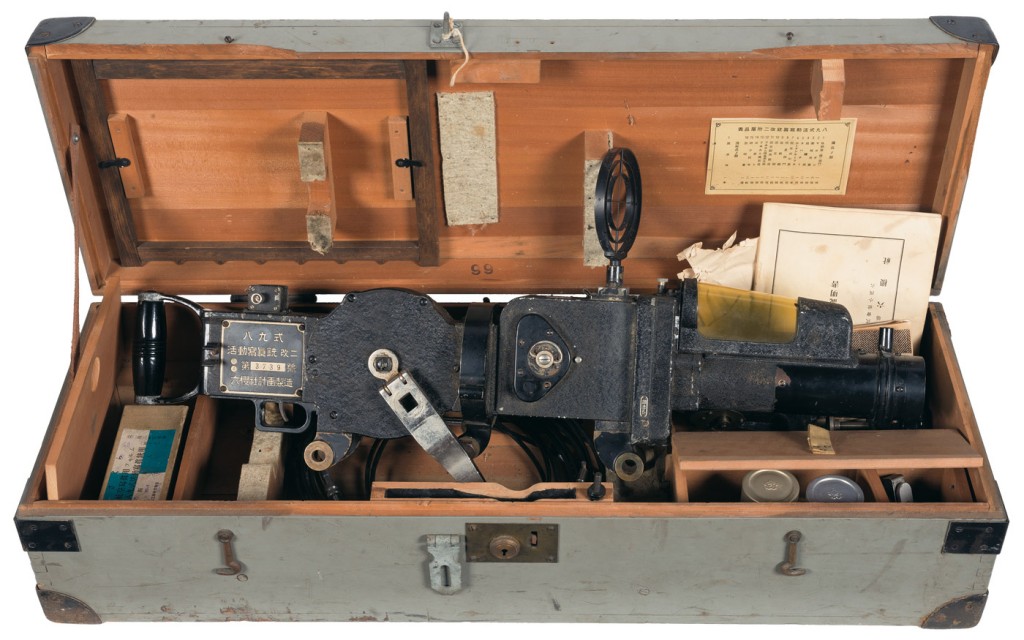 If you haven’t yet, you should definitely check out the catalog for the December Premiere auction, whether to find that next piece to add to your collection or just to gawk at all the fantastic guns. And remember, Forgotten Weapons Premium Members get 50% off the cost of the glossy print catalogs that RIA publishes for these auctions!
If you haven’t yet, you should definitely check out the catalog for the December Premiere auction, whether to find that next piece to add to your collection or just to gawk at all the fantastic guns. And remember, Forgotten Weapons Premium Members get 50% off the cost of the glossy print catalogs that RIA publishes for these auctions!

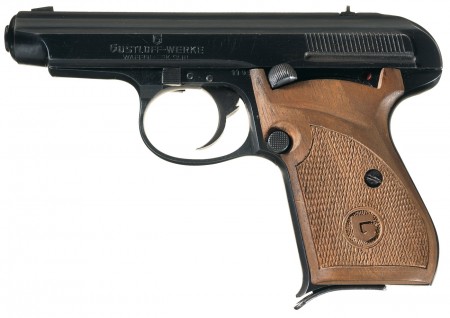
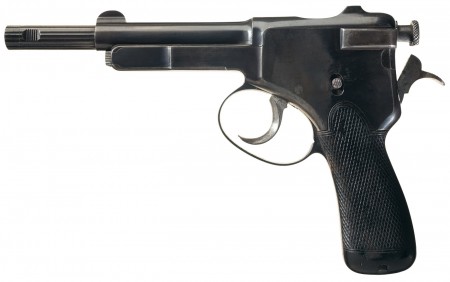
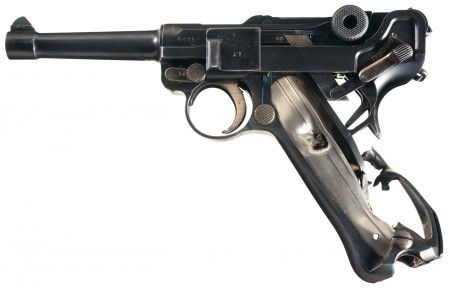



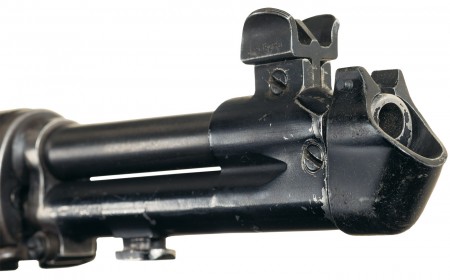

Wonder if that is the same training camera that popped up on Pawn Stars?
I try to find more info about Karel Krnka pistol, so i search for “Karel Krnka patent” and i find this:
https://www.google.com/patents/US459874?dq=ininventor:%22Karel+Krnka%22&hl=en&sa=X&ei=J9uUUvHjFOe_ygOZy4CwCg&ved=0CD4Q6AEwAQ
This patent filled in 1888, describe the pistol with rotary magazine (or revolver magazine – don’t confuse with revolver cylinder!). If I understand drawings correctly: When it is not strict automatic pistol it will fire cartridge after each trigger pull, it is actually self-extracting pistol, as the case is ejected by gas pressure and slide stay in rear position (similar to soviet PTRD-41 anti-tank rifle), after this the slide is closed by pulling the trigger.
No, there’s nothing automatic going on with this gun – the bolt is operated by moving the trigger guard, which is ring-shaped for this purpose.
Push the ring forward -> open bolt, extracting and ejecting the case.
Pull ring rearward -> close bolt, feeding a new cartridge.
If your finger is inside the ring, you also pull the trigger -> rapid fire.
Pistols like that were something of a fad in Austria-Hungary at that time, and did lead directly to the invention of automatic pistols; but they were operated entirely manually.
Yeah, Krnka was one of several guys who were making manually-operated repeating pistols prior to self-loaders. I have some data on several of them, which I will be posting sooner or later…
Thanks for explanation AMX.
On Krnka pistol in auction, the GR logo is stamped.
I know that GR is for Georg Roth (ammo manufacturer), that is mean that Georg Roth is manufacturer of this pistol or something other?
Does Krnka 1895 pistol use the 8mm cartridges for later Repetierpistole M 1907 (also know as Roth 1907)?
@ Daweo:
That’s exactly what it means – Georg Roth Jr. was a sponsor of the design and manufacturer of the prototypes. However, the designer was NOT a Krnka, yet – the 1895 model was designed according to a patent taken by one Vasa Theodorovich, himself an engineer from the Patent Office in Vienna. Roth has taken up the design, which from the start was chambered (as can be seen from the drawings in Patent 46/296 of 4 Nov 1895) for Roth-style bottle-cased rounds, fed from a metallic stripper clip (Patent 46/20 of 20 Nov 1895) into a fixed magazine inside the grip. This was a long-recoil, rotating-bolt (single-lug in a cam, later dual), hammer-fired semi-DAO design, in which the hammer was partially cocked upon the shot and had to be fully-cocked by trigger. If you de-cocked the hammer, it was put on safety and needed manual semi-cocking to fire. The pistol – as complicated as the description suggests, and more – counted 34 parts in total, only one more than the much vaunted Glock’s 33 parts. The stripper clip patent was officially transferred to Roth in 1896, and was featured in all later incarnations, while the pistol itself was manufactured by Roth and submitted to the military trails in 1896. Once again: there’s no Krnka connection to the 1895 model AT ALL – not yet.
The Roth-Theodorovich pistol have won the contest against Mannlicher 1894 (blow-forward), Salvator-Dormus and gas-tight Pieper revolver (brokered by Steyr), but only test batch of 150 was ever ordered, as Mannlicher cried foul and the contest was repeated in 1897, with Rast & Gasser revoler taking place of the Pieper – and winning orders, while the pistol shootout was won by Mauser Broomhandle. Alas, C/96 had a dubious distinction of being the sole foreigner though, and so the indigenous revolver was declared a winner. The NIH factor was not American monopoly… Mannlicher failed again to deliver a viable pistol, and lost by even greater margin.
Karel Krnka made his first impression upon the Roth pistol in 1898, replacing Theodorovich, redesigning the pistol from the scratch after the 1897 debacle, firts putting the SA/DA hammer mechanism, and then throwing the Theodorovich design into thin air and redesigning it from the scratch as striker-fired pistol. The Krnka SA/DA pistol was the Modell 1900-I, covered by patents nr 4430 of 2 Feb 1900 and 6791 of 13 July 1900 – so if you look up KRNKA pistols, look for these rather. The striker-fired Krnka pistol was later evolved into M.7 Roth-Steyr pistol, being striker-fired semi-DAO locked by rotating barrel.
Krnka was a brilliant inventor in his own right, and we don’t have to slap on him other people’s designs 🙂
And what about Roth, the ARMS and ammunition manufacturer? The 12-year struggle against the military and fellow arms manufacturers have totally discouraged Georg Roth, Jr.’s heirs from continuing along that way – even though the effort was eventually borne out by 1907 accepting of the 8 mm M.7 pistol into the inventory of the Austro-Hungarian Army. Georg Roth Jr. did not lived long enough to see that success, as he died in 1903, and his heirs have scratched the planned erection of the pistol factory – thus getting caught with their pants down by the success their father work for so long. Thus pistols had to be ordered from OEWG in Steyr, once a fierce competitor in pistol designing, now the only hope: hence the Roth-Steyr moniker of the M.7 pistol. This was deeply ironic, that this pistol actually served the Austro-Hungarian monarchy shorter (9 years: 1907-1918), that it took to design and make it work (12 years: 1895-1907).
And no, the 1895 round was the 8×22 bottle-shaped cased round (GR539)
“patents nr 4430 of 2 Feb 1900 and 6791 of 13 July 1900”
I understand this are Austrian patents. (Karel Krnka received also Germans patents on firearms, more: http://milpas.cc/rifles/ZFiles/Semi-automatic%20Rifles/Krnka-Roth%20M.1899/Krnka-Roth%20M.1899.htm )
As a certified (certifiable?) M1 fan, those two Garands sound very interesting.
I agree completely. I’ve often suspected that if the .280in (7mm) Enfield round had been adopted in, say, a modified M1 with a 20-shot detachable box (think the Beretta BM-59 series), the 7.62 NATO might never have existed except as its sporting version (.308 Winchester). And the AR-15 might have been a 7mm instead of a 5.56.
cheers
eon
I’ll go one better. With a shorter, lighter 7mm “M14,” would there have been any reason to even give the AR-15 more than just a passing glance?
Well, the straight recoil line due to the stock comb being in line with the bore would have made it very controllable in full-auto fire. Something that might be a bit tricky with even a 7mm M-14 due to the stock “drop”.
Also, a belt-fed GPMG in 7mm, such as the MAG 58, would have been very interesting. Not to mention probably working better than the M-60.
cheers
eon
There would never have been any reason for Stoner to go from the AR-10 to the AR-15 if the standard caliber were a 7mm intermediate.
Well, the barrel blowouts on the ’10 might have been an incentive. 😉
cheers
eon
“the 7.62 NATO might never have existed except as its sporting version (.308 Winchester)”
I suspect that if the 7.62 NATO wouldn’t exist, then .308 Win wouldn’t exist at all. If the army rifles would be converted to 7mm, then the .30-06 supplies would be sold cheaply as surplus, probably with older (M1903 Springfield) and non-standard (M1941 Johnson) rifle. And if you don’t need full-power .30-06 rifle, you can use .300 Savage.
Good point. But keep in mind that this was the era of “proprietary cartridges”, even more so than today. Winchester had the .270, so Remington had to have a .264, etc.
And then there was the entire Weatherby cartridge line, which Roy Weatherby first chambered in custom rifles built on FN mauser actions, before building his own distinctive Weatherby bolt system. (Which has always rather reminded me of the old Newton, actually.) Most of the early loads were ballistic duplicates of existing high-performance rounds from other manufacturers; it was only later that Weatherby became the “Lazzeroni” or “Jarrett” of the day.
The 7.62 x 51 aka .308 is basically a modified .300 Savage to begin with. I could see Winchester coming up with it on the exact principle that has made it so common today; packing .30-06 power into a short-action cartridge. Which was pretty much the whole point of the .300 Savage to begin with.
Never underestimate the power (real or perceived) of “marketing”.
cheers
eon
Yep, the Gutloff and Krnka caught m eye as well but both are out my league. However, I am watching some 1911s, Japanese pistols and the Radom.
The .280 Garand caught my attention more than all the rest (although the Gustloff gives me a case of the serious creeps – that would be in my possession for a matter of seconds before getting donated to either the National or Houston Holocaust Museum. Death-camp mementos are high on my Just Don’t Get It list.) But a small-bore Garand… when I was a kid in the Midwest in the early 70s the signature weapons of serious enthusiasts were custom quarter-inch long-range rifles… bull-barrel bolts in either .25-06 (which was still a wildcat) or the surprisingly popular .25-284 which offered the same ballistics from a short action. After being in the M-14 Navy and an early adopter (1977) of the Mini-14 I somehow settled on a National Match-style M-1 in .25-06 as my “if I win the lottery” (which I would have to play to win, but still….) dream custom rifle.
To be fair, the prototype Gustloff pistol for sale here was made in a typical factory. The plan was to mass produce them with slave labor, which never ended up happening. I tend to agree with you on the Holocaust artifacts, with the exception of guns either sabotaged by workers or captured and reused by Israel after the war.
According to Albert Speer (the man in charge of arms production for the Germans), the slave labour camps in Poland were a waste of money and resources, and overall a hindrance to German arms production.
The German arms industry was limited more by shortages of machine tools than by shortages of labour. The Germans conscripted civilians from occupied countries to work in German industry.
The arms factories set up in the camps in Poland did not make effective use of their equipment. Starting up a new factory even with experienced management and enthusiastic workers is a difficult and time consuming task (I’ve been involved in several new factory start ups). The machine tools would have been much more effectively used if they were put into existing factories of subcontractors in Germany.
The reason the factories in the Polish camps were built had more to do with German politics than with cost or practical economics. The camp system existed outside the control and budgets of the normal German state. This gave the SS an independent budget (they charged the factory operators for the use of the workers), and it gave people whose projects were turned down elsewhere a second chance to get their projects approved. The SS were also constantly lobbying to be given responsibility for “prestige” projects to raise their profile and increase their own influence.
Also, the SS were able to give contracts directly to companies who operated in the camps, rather than having to go through the normal purchasing channels. When operating through normal channels, the SS (with the exception of a few high profile divisions who got good kit for propaganda reasons) got the hand me downs the regular army didn’t want (e.g. weapons captured from defeated enemies).
Speer and his colleagues were constantly fighting with the SS as they tried to undermine each other. It’s quite possible that the Gustloff was a victim of this infighting, rather than there being anything wrong with the pistol itself. It’s quite possible that the backers of the pistol (who were not necessarily the SS directly) couldn’t get the machine tools intended for producing it, or that the machine tools were allocated to one of Walther’s subcontractors to be simply used to make more PP pistols instead.
Of course it’s also possible that the pistol was rubbish, and that the only reason it was even considered for production was that the developers/backers were willing to produce it using the SS camps.
Interesting information, MG. I didn’t know the army-SS rivalry extended into the realm of industry.
The Gustloff pistol wasn’t produced at a concentration camp. Besides, grisly origins notwithstanding, I think one can still have legitimate interest in a gun due to its rarity, design, or role in an interesting period. Plenty of firearms were manufactured with slave labor: k98, p38, vis wz.35, k43s, mg42, etc.
@ Ian H: You are completely right about Gustloff Pistol having no KZ connection.
The Gustloff-Werke was a Nazi industrial concern built out of “Arisiert” (or disposessed) ex-Jewish owned plants, like Simson in Suhl, where the pistol was actually made. It never even get close to any KZ-Lager (except maybe inside the holster of a visiting bonzo), and contrary to MG’s allegations, these were not ‘Polish’ camps, which might suggesting being Polish-operated, but merely located in Poland. And if you think I’m making fuss over a small matter, consider that: I go on your lawn and relieve myself – whose shit it is? Yours, because it sits in your lawn, or mine, because I left it? Same thing with these camps and I’m relly tired of hearing and reading about ‘Polish camps’ over and over again. They were ‘Nazi camps’, located in occupied Poland.
BTW, the KZs with small arms production lines were all situated outside Poland at all (e.g. Neuengamme in northwestern Germany, or Mauthausen in Austria) – what Nazis had in store for Jews AND Polish alike (and Gipsies, and homos, and criminals, and Bible Students, and Communists, and whoever was caught) in the camps located in Poland was not forced labor in worthwhile (or not, according to Speer) industries, but rather mass physical destruction (thus they were called the Vernichtungslager, Destruction Camps, not Konzentrationslager, Concentration Camps).
Anyway, the leaving grim KZ matters aside, the Gustloff Pistol is one of the early proponents of the mainspring being actually stretched to fire, not contracted, as usual – this feature is now revived in the Kel-Tec pistols (and their Ruger LCP knock-off).
To be absolutely clear, when I said “Polish camps”, I didn’t mean camps run by Poles. I meant camps located within the territory of Poland but owned and operated by the Germans. Perhaps you may find English to be ambiguous in that way, but I don’t seriously think that anyone would be in doubt about the status of those camps.
I mentioned the camps located in Poland specifically, because those are the ones which I recalled Speer describing in some detail. German law of that era had many specific rules about who had jurisdiction over what and where. The SS were specifically looking to get out from under the jurisdiction of the normal German state apparatus, which was controlled by their rivals (such as Speer).
If you are interested in the subject in general, you may want to read “Infiltration – How Heinrich Himmler Schemed to build an SS Industrial Empire” by Albert Speer. Of course it contains a lot of self-justification by Speer, but it also has a lot of background material on the grandiose (and impractical) plans hatched by Himmler and his supporters. Many of these plans never came to fruition due to furious lobbying efforts by Speer to undermine them.
Kudos to Jim & Ian regarding death camp guns.
The thing about those .280-converted Garands is that they really just took the design full circle. The original Garand design fired the .276 Pedersen round, and was scaled up to handle .30-06 at the Army’s insistence.
maybe someone could convert an m1 to fire what I’ve read to be the modern equivalent of the .280 British the Remington 6.8mm spc .